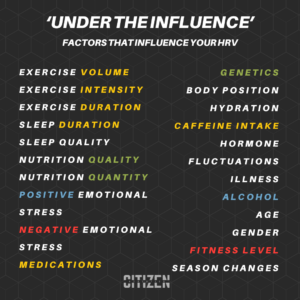In our grand finale, we are tasked with understanding the realities of an imperfect modern world. As exciting and fun as the emerging technology of health-tracking is, we’re faced with one critical issue: this industry is growing at a rate that the research can’t keep up with! Sure, the new wedding ring that tracks your sleep, heart rate variability, and exercise status is cool and all, but the only way we can make the separation between ‘High Quality Tech Data’ to ‘Super Expensive Mood Ring’ is through scientific evidence. You know? RESEARCH?!
NUMBERS & DECISIONS: DECODING THE DIFFERENCE BETWEEN DATA AND INFORMATION
While ‘data’ and ‘information’ are often used interchangeably, attempting to provide insight on metrics that should sway us one way or the other, they have a very important distinction.

Data is the raw materials. Numbers and facts that are observed or calculated about the topic of interest. A heart rate of 112bpm is ‘data.’ Fascinating, sure! But it doesn’t necessarily translate into actionable insights.
Information on the other hand, is the data that will actually influence your training strategy. Think about Information as ‘Data with Context.’ Sure, 112bpm is just ‘data,’ until you realize that you *should be in Zone 3 training and that you’re likely underdosing your threshold days. Information is data that you make decisions with.
To put some words into action (and sneak in one last definition), let’s consider the concept of Critical Power. This metric is calculated by measuring the power output your body generates at the threshold where non-oxidative metabolism kicks in1. Said differently – Critical Power measures the mechanical work done at your ‘threshold’ pace. Unlike internal measures like heart rate or lactate, critical power is a measure of actual power. You know? ‘Work divided by time.’ It doesn’t care about your fatigue state; it’s only concern is pure output.
So, what does this have to do with Data & Information? Well, knowing your Critical Power levels is only helpful if you have the tools to consistently measure it! Good luck trying to calculate your CP on a trail run filled with ups downs, uneven terrain, and uncontrollable weather patterns.
Regardless of how high our ‘ceiling’ of technology reaches, we still need a floor to stand on. And that floor is how we perceive our intensity:
Welcome to RPE.
ANCHORING INTERNAL INTENSITY WITH OBJECTIVITY: RPE & THE TALK TEST
RPE isn’t just a random number pulled from thin air; it’s deeply anchored in the research, having been a validated measure for key studies in the area 2,3. Not only is your RPE (or Rating of Perceived Exertion) a valid (accurate) and reliable (consistent) tool, but it also helps to set the stage for other ‘low tech’ options for you to stay consistent with your training.
Whether you prefer the 1-10 scale, or use the original 6-20 measure, anchoring your own feeling of intensity to your training can actually be quite precise. In fact, Glass colleagues found that runners were within 4 beats per minute of an ‘optimal’ training window when using RPE compared to Heart Rate-based Zone Training!

But that’s not all, even when we apply RPE across multiple sports and contexts, it still reigns as the ‘king of duh.’ When put up to the test with high tech sports science equipment like GPS trackers, Inertial Measurement Units (IMU’s) and other cutting edge devices, Session RPE (sRPE) had positive correlations with the highest quality measurements. This study (Marynowicz, 2020) highlights that sRPE is a practical alternative for cost-effective exercise tracking. Even better? It was tested with Soccer athletes, helping us to understand that using RPE can be helpful beyond straight-line running.
But hey, sometimes it’s hard to tell whether it feels like a 6 or a 7 out of 10, after all, it’s up to you to decide! Why don’t we make it simpler and let our bodies decide for us?!
The Talk Test harnesses your vocal cues to determine exercise intensity. If you can chat effortlessly during your session, you’re likely in the comfortable cruising lane of Zone 1. But, once your breathing takes priority over talking about last night’s Bachelor episode, we’ve entered Zone 2. Finally, if you forgot the entire conversation because all your focus has anchored to moving as much air in & out of your lungs as possible, welcome to Zone 3.
CULTIVATING TRUST IN TRAINING INTENSITY: BRIDGING PERCEPTION AND OBJECTIVITY
Bridging the gap between perception and objectivity is essential for crafting effective training programs. While the ‘research-feel’ of RPE and the Talk Test may seem abstract, they provide an accessible bridge to anchor your internal load measures (ie HR, Lactate, etc.) with perception. They allow you to transform the subjective into the tangible, aligning your perception of effort with concrete measures of intensity.

After all, what is all this tech really good for? Yeah, let’s stir that pot for a second.
REARING THE UGLY HEAD OF TECH & IT’S TRUE RELIABILITY IN EXERCISE
Who needs ‘the birds and the bees,’ it’s time we give you ‘The Talk’ about health technology.
It has become quite difficult to discuss the concept of fitness tracking, zone based training, or wearable devices without those three horrific letters creeping into the back of your mind. No no, not the FBI, even worse!
That’s right, HRV. (gasps*)
In the ever-evolving world of fitness, the only constant has become the incessant quest for gizmo’s & gadgets that ‘optimize’ exercise performance. Among the chief contenders, stealing market share and skewing public perception is Heart Rate Variability, aka ‘HRV.’ In this blog, we’ll dive into the reliability of HRV-informed training as a proxy, or representation of how the tech that we use and consume may not be as good as we want it to be.

A CLOSER LOOK INTO THE SCIENCE
HRV measures the variations in time intervals between successive heartbeats, which many claim to provide insights into your autonomic system’s ‘balance,’ which in turn is thought to affect your exercise performance and recovery process. Often marketed as a window into the complex dance between your sympathetic and parasympathetic nervous systems, we do have to admit that HRV has some basic science that makes even the most skeptical consumers eager to explore it further.
By tracking the beat to beat changes of your heart rate, HRV attempts to extrapolate the consistency of your heart’s ‘metronome’ (or lack thereof), to inform which side of your nervous system is winning in a game of tug of war.
Okay, it wouldn’t be a Citizen Athletics blog without a quick physiology lesson, so let’s dive right in!
NEUROSCIENCE FOR DUMMIES
Unless you’ve had a heart transplant, the main mechanism by which your body regulates the heart rate is through your Autonomic Nervous System (ANS).
Within the ANS there are two branches, the sympathetic and parasympathetic nervous systems, each playing a unique role in regulating physiological responses. The sympathetic nervous system, often referred to as the ‘fight or flight’ system, becomes active during times of stress or arousal; you know the ‘hype’ feeling you get when you go for a gym PR? Yeah, you got it. Well, we know on the outside it turns your face red, pumps up your veins, and forces you to slap an extra 5lbs on the bar. But on the inside, it increases heart rate, dilates airways, and redirects blood flow to muscles to prepare the body for action.
Conversely, the parasympathetic nervous system, known as the ‘rest and digest’ system, dominates during ‘chill time.’ It slows heart rate, constricts airways, and promotes digestion; all in the name of conserving our energy stores. These systems work in concert, constantly adjusting bodily functions to respond to the demands that we place on ourselves.
BENEFITS AND DRAWBACKS OF BIOMETRIC TECH
‘Biometrics’ (aka – that thing on your wrist, or strap on your chest, or anything else that flashes, buzzes, or beeps about some kind of ‘health data’) are meant to augment performance in your sport or activities of interest. Generally, they do so by giving you as much information as possible in order to put YOU in the driver’s seat as a means of making educated training decisions.
So! Let’s give credit where it’s due before… well, being more objective about things.
By tracking the beat to beat changes in your heart rate, HRV and other biometrics are able to pick up on attributes that you may not be sensitive or attuned to. This is great as it could be used as an ‘early warning system’ to prevent negative effects from training like overtraining, or prolonged overreaching. Buuuuut…
WHERE HRV FALLS SHORT
We know what HRV and other biometrics do, and why they’re used, so let’s dive into the factors that may influence your HRV numbers:

Believe me when I say I can go for hours on this. Your wrist watch, ring, smart scale, chest strap or other biometric device doesn’t know you changed your diet yesterday, or have a work meeting tomorrow that you’re freaking out about, or that you just got dumped the night before a special event. What it EXPECTS is that you’re in the same, sealed environment that measures every detail in perfect harmony, every single time.
Look back at that list once more and ask yourself this – “How many factors can I reasonably control?” I counted 7-9 out of the 21 factors above. Sometimes, stuff is just out of your control, and that’s okay!
What are you going to do? Not train because it’s Summer? Or not workout because your genetics are ‘sub-optimal’?
Yeah, didn’t think so.
Now there are other shortcomings of HRV & biometrics, but truthfully, I don’t want this to be a bash on tech. If it motivates you as a way to stay consistent and dedicated to improving fitness, I’m all for it.
So, if you ARE going to use some type of HRV data to inform your training, there are a few things you should know.
METHODS OF PROTECTION

- Know Your Tech. A lot of devices are inaccurate or inconsistent. While that isn’t always in your control, you can inform your decision-making based on knowing that the information may not always be 100% accurate. As a rule of thumb, the further away from your heart the device is, the less accurate it will likely be. Chest straps and monitors are able to use electrical signals emitted by the heart, allowing for more precise measurements than a watch or ring that extrapolates HRV based on blood flow.
- Always Anchor. Any scientist knows the limitations of relying on a single test to determine a complex issue; and trust me, ‘recovery’ is as complex as it gets. So, try to use multiple methods of tracking ‘readiness.’ Combining HRV data, with resting HR, and your perception of fatigue can be a great way to use multiple variables to better understand your readiness on a given day.
- Don’t Get in Your Head. If your watch says one thing, but you feel something different, go with how you FEEL! Remember, there are a lot of uncontrollable factors that may make your HR or HRV different than how you feel. You know your body better than any machine will.
That brings up a good point, actually. How does this tech stand up to a validated measure like RPE?
JUST BECAUSE IT’S ‘OBJECTIVE’ DOESN’T MEAN IT’S BETTER
When we compare the reliability of HRV and RPE, it’s essential to consider the context and your individual needs. HRV provides valuable insights into your nervous system’s general state of fatigue/readiness, but it can be fickle; blowing certain variables out of proportion that may not affect your true physical readiness to fitness. But, RPE offers internal self-reflection during workouts, allowing for immediate adjustments based on how you’re currently responding to training stressors.
This internal reflection and adjustment is called ‘Autoregulation’ and it’s an approach that we’re big fans of. Not only does it allow you to be the captain of your own fitness journey, but it’s also a scientifically valid method of tracking your training intensity.
In your quest for exercise optimization, remember that both HRV and RPE have their strengths and limitations. While HRV offers valuable insights into recovery and readiness, it’s essential to view it as PART of a well-rounded approach. Integrating RPE into your training regimen can help bridge the gap between physiological insights and real world performance.
ABOUT THE AUTHOR:

Dylan Carmody is a Doctor of Physical Therapy, and Strength & Conditioning Coach with 5+ years in the performance and rehab industries.
Having dabbled in training modalities like Olympic Lifting, Cycling, Powerlifting, and CrossFit, Dylan has a deep appreciationfor all things performance, while still having a positive and fun-loving approach to exercise.
Dylan’s coaching experience is equally eclectic, ranging from performance coaching for elite athletes in the NCAA D1 setting, to group fitness and weight loss coaching in his early career.
With detailed exercise programming & consistent communication, he aims to create a training environment that is not only ‘tolerable’ for clients’ aches and pains, but truly helps to resolve their issues in the first place.
SOURCES:
- Bok, Daniel et al. “An Examination and Critique of Subjective Methods to Determine Exercise Intensity: The Talk Test, Feeling Scale, and Rating of Perceived Exertion.” Sports medicine (Auckland, N.Z.) vol. 52,9 (2022): 2085-2109. doi:10.1007/s40279-022-01690-3.
- Marynowicz, J, Kikut, K, Lango, M, Horna, D, and Andrzejewski, M. “Relationship between the session-RPE and external measures of training load in youth soccer training.” J Strength Cond Res 34(10): 2800–2804, 2020.
- Cochrane-Snyman, Kristen C et al. “Treadmill running using an RPE-clamp model: mediators of perception and implications for exercise prescription.” European journal of applied physiology vol. 119,9 (2019): 2083-2094. doi:10.1007/s00421-019-04197-4.
- Chai, Guozhong et al. “Study on the Recognition of Exercise Intensity and Fatigue on Runners Based on Subjective and Objective Information.” Healthcare (Basel, Switzerland) vol. 7,4 150. 20 Nov. 2019, doi:10.3390/healthcare7040150.
- Ceci, R, and P Hassmén. “Self-monitored exercise at three different RPE intensities in treadmill vs field running.” Medicine and science in sports and exercise vol. 23,6 (1991): 732-8.
- Glass, S C et al. “Accuracy of RPE from graded exercise to establish exercise training intensity.” Medicine and science in sports and exercise vol. 24,11 (1992): 1303-7.

